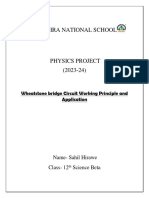Structure of Atom
1. Subatomic Particles
- Electron (e⁻): Discovered by J.J. Thomson (Cathode Ray
Experiment), charge = -1.602 × 10⁻¹⁹ C, mass ≈ 9.1 × 10⁻³¹ kg.
- Proton (p⁺): Discovered by Goldstein (Canal Rays), charge =
+1.602 × 10⁻¹⁹ C, mass ≈ 1.67 × 10⁻²⁷ kg.
- Neutron (n⁰): Discovered by James Chadwick, charge = 0, mass
≈ same as proton.
2. Atomic Models
- Thomson’s Model (Plum Pudding)
Atom is a positively charged sphere with electrons embedded.
Failed to explain atomic stability & spectral lines.
- Rutherford’s Model
Gold Foil Experiment.
Atom has a dense, small, positively charged nucleus.
Electrons revolve in orbits.
Couldn’t explain the stability of atoms (electrons should spiral
into nucleus).
� 3. Bohr’s Model of Atom
- Electrons revolve in fixed circular orbits (shells) around
nucleus.
∝
- Energy levels: Quantized (Eₙ -1/n²)
-Transition of electrons → absorption/emission of energy (line
spectra).
- Works well for hydrogen-like atoms (H, He⁺, Li²⁺).
4. Important Equations
Energy of orbit (Eₙ):
En = −13.6 eV
n²
Radius of orbit (rₙ):
rn = 0.529 × n² /Z A˚
Velocity of electron (vₙ):
vn = 2.18 × 10 × Z/n m/s
5. Electromagnetic Radiation
c = λν, where:
c = speed of light = 3×10⁸ m/s
λ = wavelength
ν = frequency
�- Planck’s Quantum Theory:
E = hν
h = Planck’s constant = 6.626 × 10⁻³⁴ J·s
6. Hydrogen Spectrum (Line Spectra)
- Lyman series: UV (n₁ = 1)
- Balmer series: Visible (n₁ = 2)
- Paschen, Brackett, Pfund: IR region
7. Quantum Numbers
1.Principal quantum number (n): Energy level, shell (n = 1,
2, 3…)
2.Azimuthal (l): Subshell (0 to n-1), s=0, p=1, d=2, f=3
3.Magnetic (m): Orientation (–l to +l)
4.Spin (s): +½ or –½
5.
8. Heisenberg Uncertainty Principle
Δx ⋅ Δp ≥ h
4π
Cannot simultaneously know exact position and momentum
of a particle.
� 9. de Broglie Equation
λ= h
mv
Matter shows wave-particle duality.
10. Aufbau Principle, Pauli Exclusion Principle, Hund’s
Rule
- Aufbau: Electrons fill orbitals from lower to higher energy
(1s < 2s < 2p < 3s…)
- Pauli: No two electrons in the same atom can have same 4
quantum numbers.
- Hund’s Rule: In degenerate orbitals, electrons fill singly
first.



























































